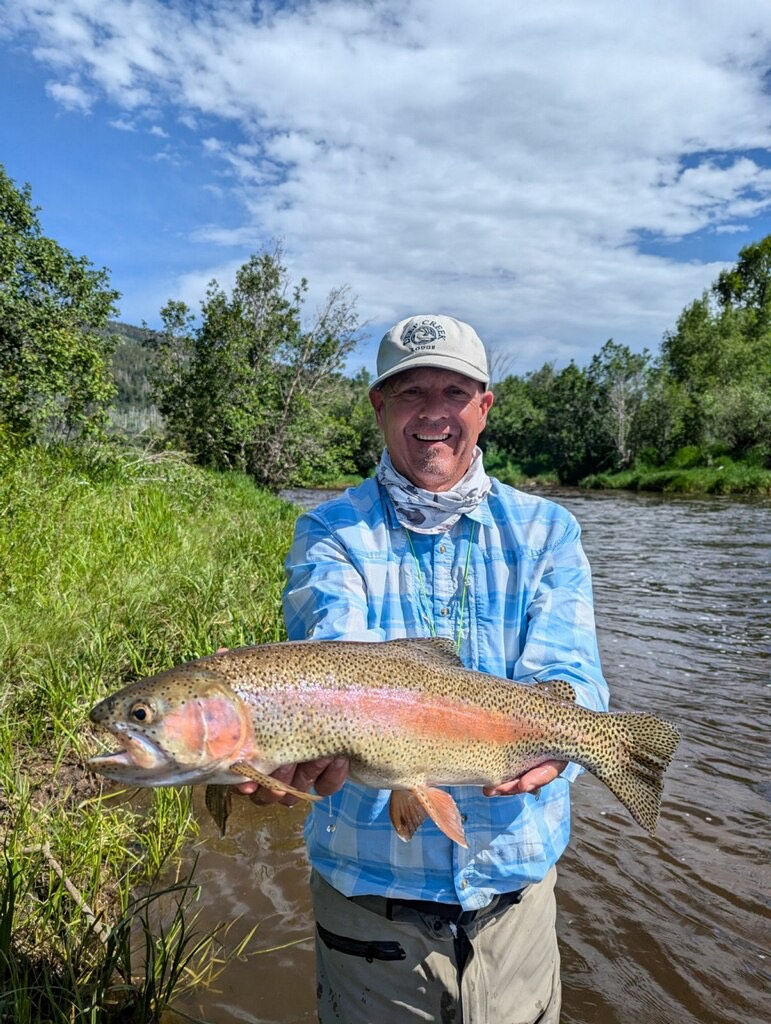Fishing Report for August 30th, 2024
- John Camponeschi
- Aug 30, 2024
- 3 min read
8/30 Fishing Report: Cooling temperatures, decreased river traffic leads to great fishing in the Yampa Valley
By John Camponeschi for Straightline Outdoor Sports
Reporting Guide: Duncan Draper
Fishing on the Yampa River has been steadily getting better as the weather cools and fall approaches.
“It’s a wonderful time of year on the Yampa,” said Straightline guide Duncan Draper. “Our temperatures are wonderful and it is nice enough during the day that you can still wet wade.”
Anglers no longer have to be on the river at daybreak and can likely spend the whole day fishing, especially as the weather continues to cool. A major decrease in the “rubber hatch” (tubers on the river) has also led to fishing on the public stretches throughout town improving.
“You’ve got a lot more area and a lot more time of day to fish places that we really haven’t gotten to fish during the prime time of hopper fishing due to the crowds on the Yampa during the day,” said Draper. “This is a pretty cool time to fish some sections downtown that you might not have fished otherwise this summer.”

Hopper fishing has been great! Draper explained that anglers should start presenting preferred patterns when they start seeing and hearing hoppers along the bank. A weighted nymph is a great fly to have 2 - 2.5 feet below the hopper pattern. Anglers should also be aware of the different types of hoppers that inhabit the banks of the Yampa River.
“Rock hoppers” have triangular wings, a gray color, and are more prevalent along rocky areas along the river's edge. Green and yellow “meadow hoppers” prefer more grassy areas. If you are fishing near rocky areas, a gray hopper pattern should be used while grassy areas call for green, yellow, and brown patterns. Great patterns for “rock hoppers” are the Donkey Kong Hopper while the Schroeder's Parachute Hopper is preferred for meadow hoppers. Focus on sizes 8 - 12.
Below the hopper, Draper likes to trail a Pheasant Tail, trico nymph imitation, Copper John, soft-hackle emerger, or a San Juan worm. When trailing nymphs, focus on presenting sizes 16 - 18.
Focus your presentations along the bank early in the day in fishy looking areas. As the day warms, fish will move into the riffles of the river. Draper likes fishing these areas during the middle and early afternoon, as the fast nature of the water forces fish “to make a decision quickly.”

There has also been a steady trico hatch recently, though Draper explained that it can be a difficult hatch to fish with dry flies due to the massive quantity of bugs on the water. As a result, he often likes to present the trico imitation behind a larger fly, such as a hopper. A drag-free downstream presentation is also a great way to put your trico imitation right in front of rising trout.
“The good trico hatches will tend to bring every fish in the river up,” he said. “When you watch the birds, it’s a good sign of what’s going on with the bugs.”
Zonkers are a great streamer imitation to also have right now. Ironically, the fly was invented by Steamboat local John Byford in the 1970’s for big trout and big pike in the Yampa River.
Anglers should use similar flies and tactics on the Elk River and its tributaries. Hatches may be a bit more sparse due to river conditions. If fish are not rising, attractor dry flies might be just what is needed to trigger a strike. The Royal Wulff, Royal Trude, Irresistible Adams, Purple Parachute, and similar patterns that “look buggy and fishy” are good options.
“The one thing that will always be a failure for you is if you don’t try it,” said Draper. “Don’t hesitate to change your fly and give it a try. You might be surprised at the results you get.”
High country lakes and reservoirs are also producing fish, with attractors being a good option in addition to Wolly Buggers, ants, beetles, hoppers, and callibaetis imitations. Draper also encouraged anglers to be observant when approaching these waterways and to use what they are seeing in the air as their patterns on the water. Damselfly, dragonfly, and water boatmen imitations, in addition to streamers, should be in the fly box for higher elevations. For creeks, attractor flies are the way to go.

As the days shorten, cool, and become cloudy, blue wing olive hatches will increase in frequency. Size 18 imitations are the fly to throw as these hatches occur. Mahogany mayflies and October caddis will also start to appear as well.
Saturday, August 31st is also the last free fly fishing clinic that Draper will be hosting at West Lincoln Park. This event, which is sponsored by Straightline Outdoor Sports, will be at the elk statue in the park at 10:30.
This report will be updated in a month or when conditions change.



Comments